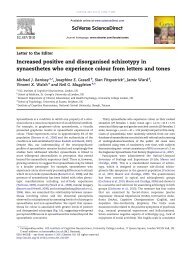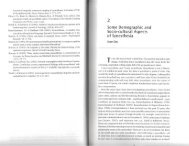A strong parietal hub in the small-world - Synesthesia
A strong parietal hub in the small-world - Synesthesia
A strong parietal hub in the small-world - Synesthesia
You also want an ePaper? Increase the reach of your titles
YUMPU automatically turns print PDFs into web optimized ePapers that Google loves.
Small-<strong>world</strong> network of coloured-hear<strong>in</strong>g synaes<strong>the</strong>tes 199<br />
Muggleton, N., Tsakanikos, E., Walsh, V., & Ward, J. (2007). Disruption of synaes<strong>the</strong>sia follow<strong>in</strong>g<br />
TMS of <strong>the</strong> right posterior <strong>parietal</strong> cortex. Neuropsychologia, 45(7), 1582–1585.<br />
doi:10.1016/j.neuropsychologia.2006.11.021<br />
Mulert, C., Jager, L., Schmitt, R., Bussfeld, P., Pogarell, O., Moller, H. J., et al. (2004).<br />
Integration of fMRI and simultaneous EEG: Towards a comprehensive understand<strong>in</strong>g of<br />
localization and time-course of bra<strong>in</strong> activity <strong>in</strong> target detection. Neuroimage, 22(1), 83–94.<br />
doi:10.1016/j.neuroimage.2003.10.051<br />
Muller, T. J., Federspiel, A., Horn, H., Lovblad, K., Lehmann, C., Dierks, T., et al. (2005).<br />
The neurophysiological time pattern of illusionary visual perceptual transitions: A simultaneous<br />
EEG and fMRI study. International Journal of Psychophysiology, 55(3), 299–312.<br />
doi:10.1016/j.ijpsycho.2004.09.004<br />
Näpfl<strong>in</strong>, M., Wildi, M., & Sarn<strong>the</strong><strong>in</strong>, J. (2007). Test-retest reliability of rest<strong>in</strong>g EEG spectra<br />
validates a statistical signature of persons. Cl<strong>in</strong>ical Neurophysiology: Official Journal<br />
of <strong>the</strong> International Federation of Cl<strong>in</strong>ical Neurophysiology, 118(11), 2519–2524.<br />
doi:10.1016/j.cl<strong>in</strong>ph.2007.07.022<br />
Northoff, G., He<strong>in</strong>zel, A., de Greck, M., Bermpohl, F., Dobrowolny, H., & Panksepp, J. (2006). Selfreferential<br />
process<strong>in</strong>g <strong>in</strong> our bra<strong>in</strong>–a meta-analysis of imag<strong>in</strong>g studies on <strong>the</strong> self. Neuroimage,<br />
31(1), 440–457.<br />
Nunn, J. A., Gregory, L. J., Brammer, M., Williams, S. C., Parslow, D. M., Morgan, M. J., et al. (2002).<br />
Functional magnetic resonance imag<strong>in</strong>g of synes<strong>the</strong>sia: Activation of V4/V8 by spoken words.<br />
Nature Neuroscience, 5(4), 371–375. doi:10.1038/nn818<br />
Oostenveld, R., & Praamstra, P. (2001). The five percent electrode system for high-resolution<br />
EEG and ERP measurements. Cl<strong>in</strong>ical Neurophysiology, 112(4), 713–719. doi:10.1016/S1388-<br />
2457(00)00527-7<br />
Opsahl, T. (2009). Structure and evolution of weighted networks. (Doctoral dissertation). Queen<br />
Mary College, University of London: London.<br />
Opsahl, T., Colizza, V., Panzarasa, P., & Ramasco, J. J. (2008). Prom<strong>in</strong>ence and Control: The<br />
Weighted Rich-Club Effect. Physical Review Letters, 101(16), 1–14. doi:10.1103/PhysRevLett.<br />
101.168702<br />
Opsahl, T., & Panzarasa, P. (2009). Cluster<strong>in</strong>g <strong>in</strong> weighted networks. Social Networks, 31(2),<br />
155–163. doi:10.1016/j.socnet.2009.02.002<br />
Orekhova, E. V., Stroganova, T. A., Posikera, I. N., & Malykh, S. B. (2003). Heritability and<br />
“environmentability” of electroencephalogram <strong>in</strong> <strong>in</strong>fants: The tw<strong>in</strong> study. Psychophysiology,<br />
40(5), 727–741. doi:10.1111/1469-8986.00073<br />
Pascual-Marqui, R. D. (2002). Standardized low-resolution bra<strong>in</strong> electromagnetic tomography<br />
(sLORETA): Technical details. Methods and F<strong>in</strong>d<strong>in</strong>gs <strong>in</strong> Experimental and Cl<strong>in</strong>ical Pharmacology,<br />
24(D), 5–12.<br />
Paulesu, E., Harrison, J., Baron-Cohen, S., Watson, J. D., Goldste<strong>in</strong>, L., Hea<strong>the</strong>r, J., et al. (1995). The<br />
physiology of coloured hear<strong>in</strong>g. A PET activation study of colour-word synaes<strong>the</strong>sia. Bra<strong>in</strong>,<br />
118(Pt 3), 661–676. doi:10.1093/bra<strong>in</strong>/118.3.661<br />
Piefke, M., Weiss, P. H., Zilles, K., Markowitsch, H. J., & F<strong>in</strong>k, G. R. (2003). Differential remoteness<br />
and emotional tone modulate <strong>the</strong> neural correlates of autobiographical memory. Bra<strong>in</strong>, 126(Pt<br />
3), 650–668. doi:10.1093/bra<strong>in</strong>/awg064<br />
P<strong>in</strong>eda, J. A. (2005). The functional significance of mu rhythms: Translat<strong>in</strong>g “see<strong>in</strong>g”<br />
and “hear<strong>in</strong>g” <strong>in</strong>to “do<strong>in</strong>g”. Bra<strong>in</strong> Research Bra<strong>in</strong> Research Reviews, 50, 57–68.<br />
doi:10.1016/j.bra<strong>in</strong>resrev.2005.04.005<br />
Ponten, S. C., Daffertshofer, A., Hillebrand, A., & Stam, C. J. (2010). The relationship between<br />
structural and functional connectivity: Graph <strong>the</strong>oretical analysis of an EEG neural mass model.<br />
Neuroimage, 52(3), 985–994. doi:10.1016/j.neuroimage.2009.10.049<br />
Posthuma, D., Neale, M. C., Boomsma, D. I., & de Geus, E. J. (2001). Are smarter bra<strong>in</strong>s runn<strong>in</strong>g<br />
faster? Heritability of alpha peak frequency, IQ, and <strong>the</strong>ir <strong>in</strong>terrelation. Behavior Genetics,<br />
31(6), 567–579. doi:10.1023/A:1013345411774




